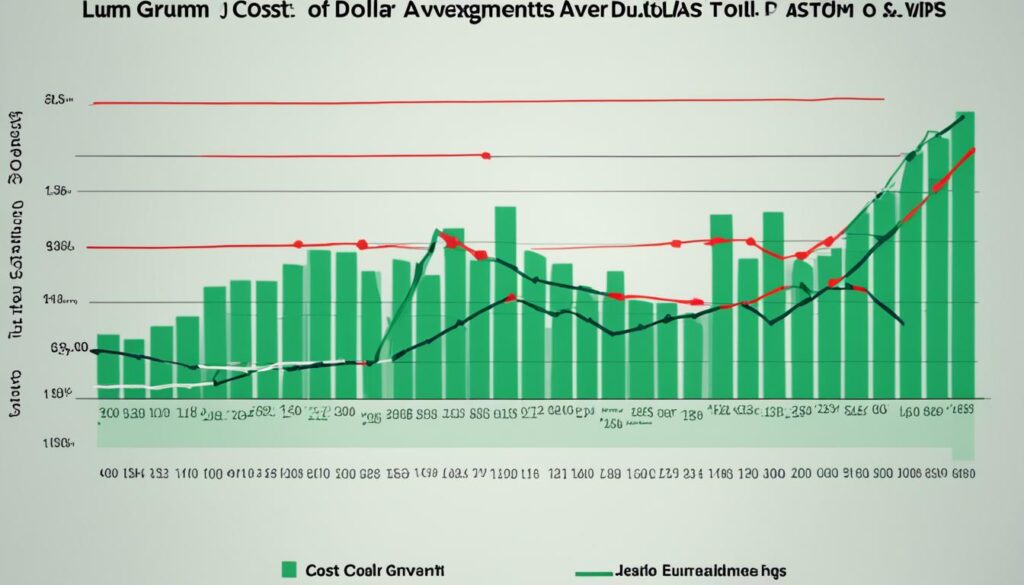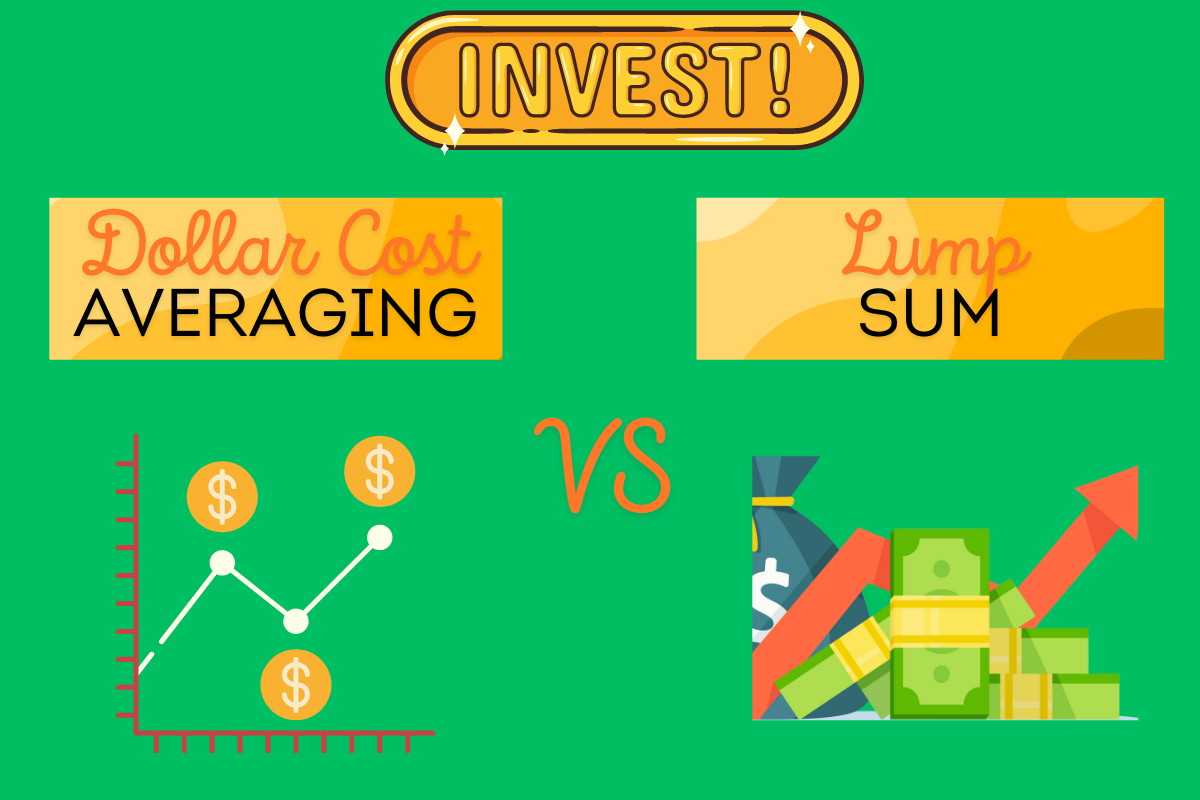Did you know that lump sum investing has outperformed dollar cost averaging (DCA) strategies 68% of the time across global markets? This is true even after just a one-year investment. A Vanguard research paper brings this surprising fact to light. It highlights the debate between these two common investment methods. Knowing the differences and benefits of each can really help boost your long-term gains. Let’s explore Dollar Cost Averaging vs Lump sum investing.

When you have a chunk of money to invest, there are two main ways you could do it. You could either invest it all at once (a lump-sum investment) or spread it out over time (DCA). Vanguard research shows that, in general, investing everything at once wins out. This is because markets often tend to go up. So, the sooner you invest, the more you’ll likely make.
But there’s a catch. Going all in at once might not be the best move for everyone. It might lead to a big loss if the market drops sharply. That’s where DCA shines. It could be a better option for people who are cautious with their risks. They might spread out their investments to avoid big losses on a single bad day. However, choosing DCA might mean you miss out on bigger gains if the market mostly goes up.
Key Takeaways
- Lump sum investing has outperformed dollar cost averaging (DCA) 68% of the time across global markets, even with a one-year investment horizon.
- Lump sum investing tends to deliver higher returns on average, as markets generally rise over time.
- DCA may be more suitable for risk-averse investors who want to minimize the risk of large drawdowns, despite lower potential returns.
- Factors like risk tolerance, market conditions, and investment horizon should be considered when choosing between lump sum and DCA strategies.
- Implementing a disciplined investment plan and avoiding emotional biases are crucial for long-term success, regardless of the strategy chosen.
Understanding Dollar Cost Averaging and Lump Sum Investing
Investors face a choice when putting a large sum of money into the market. They can use dollar cost averaging (DCA) or jump in with a lump sum. Knowing the differences between these investment strategies is crucial. It helps investors match their approach to their goals, how much risk they can handle, and how long they plan to invest.
What is Dollar Cost Averaging?
In dollar cost averaging, investors spread out their investment over time. For example, they might buy shares of a stock or a mutual fund every month. This method can help soften the blow of ups and downs in the market. It lets investors buy more shares when prices are low and fewer when prices are high. Over time, this can lower the average cost of each share they own.
It’s a slow and steady strategy that can help those who are nervous about market changes. They might not catch the very lowest price, but they can avoid buying at the highest. This evens out the cost of their shares over time.
What is Lump Sum Investing?
On the flip side, lump sum investing means putting all your money in at once. If you think the market is about to rise, this can be a good move. Since the money is all in the market from the start, it can benefit from early market gains. This approach might be better for people with long investment time horizons. If the market grows steadily, it could overshadow any losses during market dips.
History and Performance: Lump Sum vs Dollar Cost Averaging
The conversation between lump sum investing and dollar cost averaging (DCA) strategies is always buzzing in the investor world. Vanguard’s research found that lump sum investing usually works better than DCA. This was true in 68% of cases, looking at global markets over one year.
Historical Data Analysis
Vanguard’s study compared the success of lump sum and DCA methods. It used a $100,000 starting point and looked at three kinds of investments. Across the board, choosing the lump sum was the smarter move over a DCA setup.
Impact of Investment Horizon
The study dug into how the length of time affects the choice between lump sum investing and DCA. In short terms, lump sum tends to do better. Yet, over longer times, DCA might catch up. This depends on market cycles and how the investor handles risk.
The right pick should take into account how much risk you’re willing to take. Also, think about the chance for compound interest and how mixed you want your investment to be.

Dollar Cost Averaging vs Lump Sum Investing: Factors to Consider
Deciding between lump sum investing and dollar cost averaging (DCA) involves several important factors.
Risk Tolerance and Loss Aversion
Risk tolerance plays a vital role in this choice. Lump sum investing benefits those with a high-risk tolerance. It lets them gain from market spikes quickly. On the other hand, loss aversion, a common bias, might lead others to prefer DCA. This method helps avoid large losses, even though it might lower total returns.
Market Conditions and Timing
Market conditions and an investor’s timing skills are key too. Choosing a lump sum is better if one thinks the market is low. It means they can benefit sooner from favorable times in the market. In contrast, using DCA in unstable markets could be safer. This helps reduce the effects of market volatility.
| Factors to Consider | Lump Sum Investing | Dollar Cost Averaging |
|---|---|---|
| Risk Tolerance | Higher risk tolerance | Lower risk tolerance |
| Loss Aversion | Maybe less comfortable with potential losses | May provide more comfort in volatile markets |
| Market Conditions | Advantageous in undervalued markets | Preferable in volatile or uncertain markets |
| Investment Timing | Allows immediate market exposure | Gradual market exposure over time |

Strategies for Implementing Dollar Cost Averaging
Using a dollar cost averaging (DCA) strategy needs some thought. It’s important to pick the right investment amounts and how often to invest. These choices greatly sway how well DCA works. Also, making your investments automatic is smart. It keeps your approach steady and reliable.
Determining Investment Amounts and Frequency
Deciding on investment amounts and how often to invest is key in DCA. You want to find a good mix. This mix should lead to steady, balanced investments without hurting your asset allocation or risk management goals. Thoughtful considerations include your cash flow, how much risk you’re comfortable with, and what you aim to achieve in the long run.
Automating Investments
Many people choose to automate their DCA investments. It’s a handy way to keep to your plan without getting off track. By setting up regular buys, like weekly or monthly, you stay on course. This keeps you from making changes based on the market’s current state or your feelings. Doing this boosts the safety net that DCA offers.
Psychological Aspects of Investing
Investing means handling money with numbers and feelings. How we think and act can change our best move when choosing between:
Lump Sum Investing
and
Dollar Cost Averaging (DCA)
Knowing how our emotions and thoughts affect our choices is key. It helps us create a strong and steady investment plan.
Emotional Biases and Behavioral Finance
Our feelings can lead us to make bad choices when investing. Take, for instance, risk aversion. It might make us not want to invest everything at once, preferring to spread it out. But, the facts show that investing all at once can actually do better. And then there’s loss aversion, where we feel losing money more than gaining it. This can make us too scared to invest and miss out on growth.
Sticking to Your Investment Plan
After picking how to invest, either lump sum or spread it out, sticking to it is key. Being tempted to change our plans by trying to guess the market can lead to mistakes. Building a diversified portfolio and sticking to your investment strategy can keep you on the right path. It helps avoid making emotional choices that might hurt your investments.
Which Method is best for you?
In the debate between lump sum investing and DCA, research points to lump sum as the winner. Over time, markets mostly go up. This means those who invest a big amount at once can grab those gains right away.
DCA can be better for those who are scared of big losses. But, data over the long term shows lump sum investing works better for most. It’s important to consider your own ability to handle risk, the market’s state, and how our minds can trick us.
The perfect investment approach depends on your personal situation. This includes how long you plan to invest and how much risk you’re comfortable with. Thinking about both the numbers and your behavior can help you make the best choice for your future.
So, invest wisely when deciding between dollar cost averaging vs lump sum investing.
Happy Investing!
FAQ
What is the difference between dollar cost averaging and lump sum investing?
Which strategy tends to perform better, on average?
What factors should be considered when choosing between lump sum and DCA?
How can an investor implement a DCA strategy effectively?
How do psychological and behavioral factors influence the choice between lump sum and DCA?
Source Links
- https://investor.vanguard.com/investor-resources-education/news/lump-sum-investing-versus-cost-averaging-which-is-better
- https://www.morganstanley.com/articles/dollar-cost-averaging-lump-sum-investing











